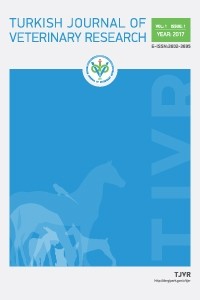Comparison of Some Bacterial Identification Methods
Comparison of Some Bacterial Identification Methods
Bacteria, Identification, Conventional methods, Automated systems,
___
- Arda M (2006). Temel Mikrobiyoloji, 3. Baskı, 80-102, Medisan Yayınları, Ankara.Barenfanger J, Drake C, Kacich G (1999). Clinical and financial benefits of rapid bacterial identification and antimicrobial susceptibility testing. J Clin Microbiol, 37 (5):1415-1418.Berktaş M (2009). Otomatize tanımlama sistemleri tanımlamada artıları ve eksileri. Klinik Mikrobiyoloji Uzmanlığı ve Laboratuvar Uygulamaları Sempozyumu, 23-24 Ekim 2009 Ankara.Blankenfeld-Enkvist GV, Brannback M (2002). Technological trends and needs in food diagnostics. Technol Review, 132/2002.Carroll KC, Glanz BD, Borek AP, Burger C, Bhally HS, Henciak S, Flayhart D (2006). Evaluation of the BD Phoenix Automated Microbiology System for Identification and Antimicrobial Susceptibility Testing of Enterobacteriaceae, J Clin Microbiol, 44 (10), 3506-3509.Carter GR (1984). Diagnostic Procedurs in Veterinary Bacteriology and Mycology. Fourth edition. Springfield,Illinois, USA.Felmingham D, Brown DFJ (2001). Instrumentation in antimicrobial susceptibility testing. J Antimicrobial Chemother, 48 (Suppl 1): 81-85.Ferraro MJ, Jorgenson JH (1999). Manual of clinical microbiology, susceptibility testing instrumentation and computirized expert sysytems for data analysis and interpretation. In: Murray PR, Baron EJ, Pfalller MA, Tenover FC and Yolken RH (eds). 7th ed. Washington, DC: American Society for Microbiology, pp:1539-600.Fung DYC (2002). Rapid methods and automation in microbiology. Compreh Rev Food Sci Food Safety, 1: 3-21.Fung DYC (2006). Rapid methods and automation in microbiology: 25 years of development and predictions. Bull Tech U Ist, 54 (4): 45-55.Gülaydın Ö (2018). Sığırların solunum yolundan izole edilen Pasteurella multocida fenotip ve genotiplerinde virülens genlerin dağılımı. Van Yüzüncü Yıl Üniversitesi Sağlık Bilimleri Enstitüsü Mikrobiyoloji Anabilim Dalı Doktora Tezi, Van.Koneman EW, Allen SD, Dowel VR, Janda WM, Sommers HM, Winn WC (1988). Color Atlas and Text Book of Diagnostic Microbiology. Third edition. Lippincott Comp. Philadelphia, USA.Koneman EW, Allen SD, Janda WM, Schreckenberger PC, Winn WC (1997). Guidelines for the collection, transport, processing, analysis and reporting of cultures from specific specimen sources. In: Koneman EW, Allen SD, Janda WM, Schreckenberger PC, Winn WC (eds). Color Atlas and Textbook of Diagnostic Microbiology. 5th ed. New York: Lippincott Philadelphia, pp:121-70.Layer F, Ghebremedhin B, Moder KA, König W, König B (2006). Comparative study using various methods for identification of Staphylococcus species in clinical specimens. J Clin Microbiol. 44 (8): 2824-2830.Lenette EH, Balows A, Hausler JWJ, Shadomy JH (1985). Manual of Clinical Microbiology. USA. 4, 1149.Lizarazo YAV, Ferri EFR, Martı´n CBG (2008). Evaluation of different API systems for identification of porcine Pasteurella multocida isolates. Res Vet Sci, 85, 453-456.Menozzi MG,Eigner U, Covan S, Rossi S, Somenzi P, Dettori G, Chezzi C, Fahr AM (2006). Two center collaborative evaluation of performance of the BD Phoenix micribiology system for identification and antimicrobial susceptibility testing of Gram Negative Bacteria. J Clin Microbiol. 44 (11): 4085–4094.O’Hara CM (2006). Evaluation of the Phoenix 100 ID/AST System and NID panel for identification of Enterobacteriaceae, Vibrionaceae, and commonly isolated nonenteric Gram negative bacilli. J Clin Microbiol. 44 (3): 928–933.Snyder JW, Munier GK, Johnson CL (2008). Direct comparison of the BD phoenix system with the MicroScan WalkAway system for identification and antimicrobial susceptibility testing of Enterobacteriaceae and nonfermentative Gram negative organisms. J Clin Microbiol. 46 (7): 2327-2333. Stefaniuk E, Baraniak A, Gniadkowski M, Hryniewicz W (2003). Evaluation of the BD Phoenix Automated Identification and Susceptibility Testing System in Clinical Microbiology Laboratory Practice, Eur J Clin Microbiol Infect Dis, 22, 479–485.
- Başlangıç: 2017
- Yayıncı: Ebubekir CEYLAN
Comparison of Some Bacterial Identification Methods
Özgül GÜLAYDIN, İsmail Hakkı EKİN, Cihat ÖZTÜRK, Ziya İLHAN, Erdal ÖĞÜN
Abolfazl JAFARİ-SALES, Azizeh SHADİ-DİZAJİ
Muhammad Zeeshan AKRAM, Muhamad SALMAN, Hassan JALAL, Umair ASGHAR, Zeshan ALİ, Muhammad Hassan JAVED, Minahil KHAN
The Microbiological Quality of Tantuni
Evan Abdulkarim MAHMOOD, Tahir KAHRAMAN
Prevalence of Gastrointestinal Helminths in Stray Dogs in Van Province
